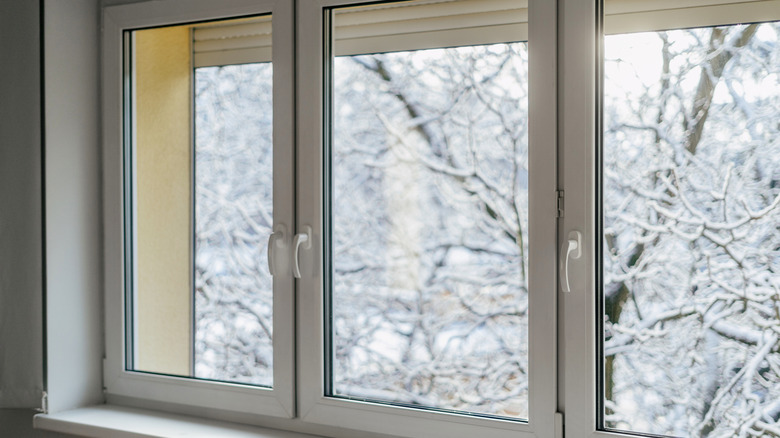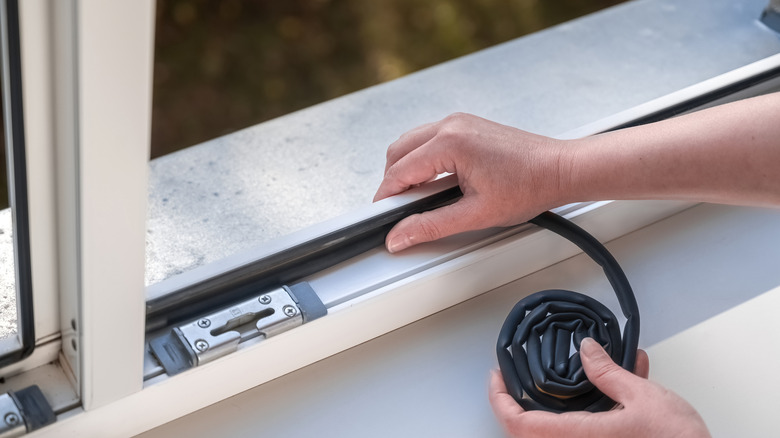The Best Way To Weather Strip Your Windows & Keep Extreme Temperatures At Bay
We may receive a commission on purchases made from links.
Your windows might seem like they're doing their job, but even the smallest cracks can let in extreme temperatures and force your heating and cooling system to work overtime in the process. Those gaps allow heat to escape during winter and seep in during summer, which not only affects your comfort, but also your energy bill. The best way to stop this problem is weather stripping — a quick, affordable, and highly effective method to keep your home sealed. It might be time to reseal your drafty windows to keep you warm and cozy regardless of the season, but how do you do it?
The key to getting the best results lies in choosing the right type of weather stripping for your windows. Foam tape is ideal for awkward gaps because it compresses easily, while felt works well on windows that stay shut most of the time. For movable windows, v-strip (or tension seal) is the best choice, as it flexes with the movement of the sash. Silicone and rubber gaskets are the most durable and perfect for a long-term oriented solution.
Before you start applying any weather stripping, clean the frame to remove dust and debris. Then measure the length of your window's edges, cutting each strip to fit snugly. Press them in place, ensuring no gaps remain. This simple upgrade can significantly reduce energy waste, saving you money and making your home more comfortable in every season.
Keeping the cold air out with weather strips
Cold air sneaking through window gaps during the winter can quickly turn your home into an icebox. While it's tempting to just crank the thermostat higher, that won't fix the real problem: drafts. Winter drafts aren't just an inconvenience, they can spike your heating bill and make your home feel perpetually chilly no matter how high you set the thermostat. The key to keeping cold air at bay is to choose the right insulation kit that will keep you warm and cozy through winter, sealing every entry point around your windows. Start by checking for any obvious gaps by running a hand around the edges of the frame on a particularly windy day. Even the smallest leaks can add up, and if you can feel a breeze, you might be in need of a quick fix.
Foam weather stripping is your best friend if you're in need of a quick solution because it's flexible, easy to install, and seals tight against uneven surfaces. For a more robust option, consider tubular rubber or silicone strips — they offer an airtight seal and last through harsh winters. Another overlooked solution is removable caulk or sealant — think Seal 'N Peel — which you can peel off when warmer months arrive. Don't forget to seal the top and bottom sashes on double-hung windows as gaps often form in these spots. Apply V-strip or tension seals to keep insulation. This two-pronged approach not only prevents cold air from seeping in, but also keeps the warmth that you're paying for right where it belongs.
Weather stripping windows for extreme heat
When summer temperatures climb, your windows can be a major weak spot, letting hot air in. That means your AC is working double time, and your energy costs soar. The solution? Weather stripping. Sealing the gaps around your windows creates an unseen barrier that keeps cold air inside your home all summer long. It's an affordable, easy-to-do upgrade that makes a huge difference in how your home feels — especially when combined with other cooling strategies.
For hot weather, make sure to choose materials that can handle intense sun without breaking down. Rubber and silicone strips are top performers because they resist heat, moisture, and cracking even in high temperatures. If you have sliding windows, adhesive backed vinyl strips are a smart option because they won't interfere with the actual functionality of your window. Before applying your new weather strips, remove any old material and clean the frame thoroughly to ensure a strong bond. Measure each edge carefully, cut to size, and press the strips firmly in place. It should compress when the window is shut, letting you know that you've done it properly.
The installation process for each type of weather stripping can differ slightly, so you should be mindful of the specifications. For extra defense against heat, layer reflective window film or install solar shades to reduce the amount of sunlight coming through your windows. A few dollars and a little effort can go a long way in helping you remain cool all summer long, without breaking the bank. If you still notice that your home gets extremely hot, you may also want to consider weather stripping your exterior doors.


